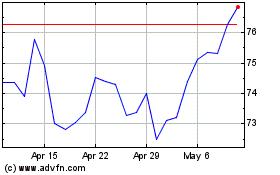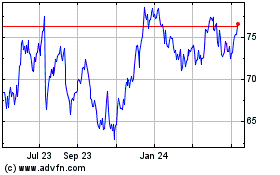State Street Hedge Fund Study of Institutional Investors Shows Investment Boards Gaining More Comfort with Hedge Funds
March 21 2007 - 9:30AM
Business Wire
State Street Corporation (NYSE: STT), the world�s leading provider
of financial services to institutional investors, released today
its third institutional investor hedge fund study. State Street
conducted the study late last year in conjunction with the 2006
Global Absolute Return Congress (Global ARC). Asset owners
participating in the study included representatives from global
corporate pensions (21 percent), public and government pensions (32
percent), and endowments and foundations (44 percent), with
investable assets totaling more than $1 trillion. According to
State Street�s study, more than half of respondents indicated that
their governing bodies are more comfortable investing in hedge
funds today than they were 12 months ago. Reinforcing this
interest, more than half of boards also spend 15 percent or more of
their time on the subject. �The findings of our study reinforce the
industry trend we�ve been witnessing among our client base ?
investment boards are overwhelmingly accepting that hedge funds are
a viable option for their investment allocations,� said Gary Enos,
executive vice president and head of State Street�s alternative
investment servicing business. �They are also discovering the
various ways hedge funds can be incorporated into portfolios based
upon investors� risk appetite, return targets and overall
investment objectives.� Results also show that the percentage of
asset owners investing in alternatives increased significantly over
last year. This year, only 4 percent of asset owners indicated they
have no hedge fund investments, down from 16 percent last year. All
of the study participants said they allocate assets to private
equity. Ongoing Challenges Cited Include Risk Management, Accurate
Valuations Half of institutional investors said the negative
financial effects of recent highly publicized hedge fund manager
debacles on institutional portfolios have prompted their boards to
call for a more robust risk management program. Nearly half cited a
need for additional reporting and analysis on the part of hedge
fund managers and more rigorous due diligence practices. Less than
5 percent of institutions plan to add to their staff to address
these concerns. More participants will also increase use of
third-party resources for due diligence, fund screening and/or
investment recommendations. In addition, nearly half of
institutions acknowledge that in-house risk management tools and
analysis could be more robust. A majority of institutions said they
find it difficult to gain a portfolio-wide view of risk, and that
aggregating risk statistics provided by all hedge funds in their
portfolio was problematic. The same number also agreed that
obtaining an accurate valuation of hedge fund holdings can be
problematic. �The tools, methods and best practices for managing
risk will further develop as hedge funds become a tried and true
staple of institutional portfolios,� said Enos. �Particularly in
light of regulatory pressure and changes in accounting practices,
asset owners will continue to push hedge fund managers and
third-party service providers, such as administrators, to develop
and deliver enhanced risk and transparency solutions.� More Direct
Hedge Fund Managers Are Hired The number of hedge fund managers
hired directly by a single institution has increased. More than
half (56 percent) of the study participants said they invest with
more than 10 direct hedge fund managers. The prior year, only 48
percent said they invested with more than 10 direct managers. This
shift implies that portfolio construction is following current
empirical evidence supporting a properly diversified portfolio of
hedge funds to mitigate systemic risk. By contrast, the number of
funds of hedge funds used by institutions appears to have declined.
In the 2007 study, nearly a third of institutions indicated they
used no fund-of-funds managers, as compared with just over a
quarter of institutions in the 2006 study. Nearly two-thirds (60
percent) said they employ the services of between one and three
fund-of-funds managers and only 8 percent used four or more. This
represents a shift from the 2006 study, in which 43 percent of
institutions said they used between one and three fund-of-funds
managers and 29 percent used four or more. Evidence suggests that
reduced use of fund-of-funds is likely due to two factors: growing
sophistication and familiarity with hedge fund investing, and a
cost-benefit analysis in favor of a �do-it-yourself� approach. A
Focus on Fees The results of State Street�s study also show that
institutions are concerned about hedge fund fees. High fees
offsetting returns was identified as the greatest threat to hedge
fund investing by nearly a third of institutions. That concern was
closely followed by headline risk (20 percent) and investment loss
(20 percent). �As fees continue to eat away at precious returns,
more institutions will balk at paying �alpha� fees for �beta�
performance,� said Jane Tisdale, senior managing director of
Absolute Return Strategies at State Street Global Advisors. �Asset
owners will likely begin to force fee compression for all but the
most successful funds.� For a copy of the State Street hedge fund
research study, please contact publicrelations@statestreet.com.
Next month, State Street will launch the second of its State Street
Vision papers ? State Street branded thought leadership white
papers including input and insights from across the company. The
inaugural Vision paper was on the topic of Asian Bonds and the
second paper will address timely issues within the hedge fund
arena. State Street Corporation (NYSE: STT) is the world's leading
specialist in providing institutional investors with investment
servicing, investment management and investment research and
trading services. With US$11.9 trillion in assets under custody and
US$1.7 trillion in assets under management as of December 31, 2006,
State Street operates in 26 countries and more than 100 geographic
markets worldwide. For more information, visit State Street's
website at www.statestreet.com. This news release may contain
forward-looking statements, as defined by federal securities laws,
including statements about the financial outlook and business
environment. Any such statements are based on current expectations
and involve a number of risks and uncertainties. Important factors,
including those mentioned in this news release, that could cause
actual results to differ materially are set forth in the company�s
2006 annual report and subsequent SEC filings. They include risks
and uncertainties relating to the pace at which State Street adds
new clients or at which existing clients use additional services,
the value of global and regional financial markets, and the
dynamics of the markets State Street serves. State Street
encourages investors to review its annual report and SEC filings in
conjunction with this announcement and prior to making any
investment decision. The forward-looking statements contained in
this news release speak only as of the date of release, March 21,
2007, and the company does not undertake to revise those
forward-looking statements to reflect events after the date of this
release.
State Street (NYSE:STT)
Historical Stock Chart
From Jul 2024 to Aug 2024

State Street (NYSE:STT)
Historical Stock Chart
From Aug 2023 to Aug 2024
